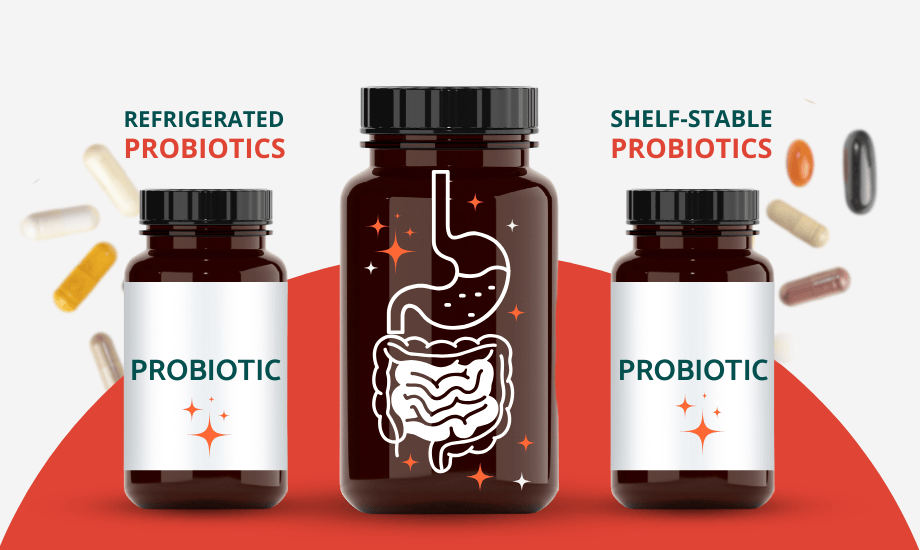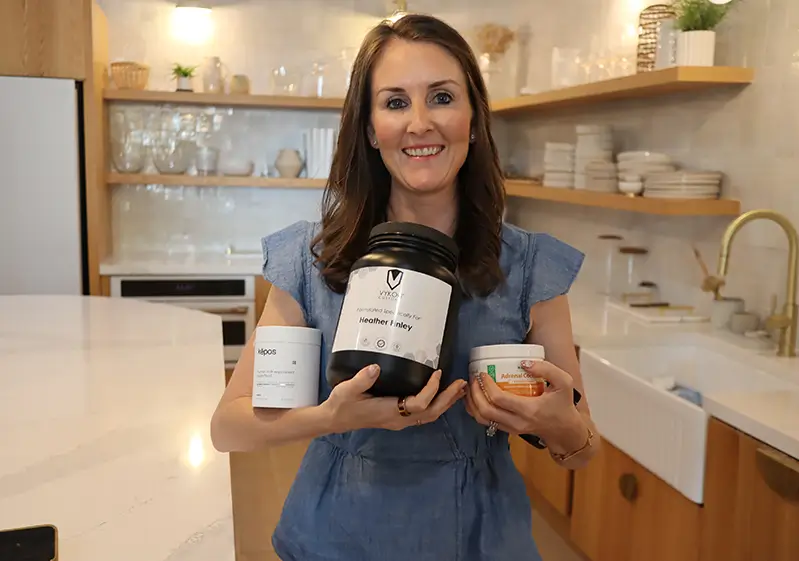Introduction
Probiotics have become a popular supplement for improving gut health, but understanding how to choose the right one can be confusing. Probiotics are live microorganisms, often referred to as “good” bacteria, that support digestion, nutrient absorption, and overall health by maintaining a balanced gut microbiome. However, not all probiotics are created equal. The effectiveness of a probiotic depends on the strains it contains, the dose, and how well it survives the journey to your intestines.
When selecting a probiotic, many people make the mistake of going to their local health food store and purchasing the most expensive option, assuming that a higher price or a greater number of strains means a better product. In reality, probiotics are highly strain-specific, meaning the particular bacteria used and their dosage are key to addressing specific digestive or immune concerns.
In this blog, we’ll focus on the two main types of probiotics: refrigerated and non-refrigerated. We’ll also classify the different types of non-refrigerated probiotics, including spore-based probiotics and live & active culture probiotics, explaining when each is most beneficial and how to make the right choice based on your health goals.
What Are Shelf-Stable Probiotics?
Shelf-stable probiotics are specially formulated probiotics that do not require refrigeration, maintaining their potency at room temperature. This is possible through various methods of preservation, such as freeze-drying or encapsulating the probiotics in protective coatings. These techniques help maintain the viability of the bacteria during storage and ensure they survive the journey through the digestive system.
One of the key benefits of shelf-stable probiotics is convenience. Since they don’t need to be refrigerated, they are ideal for travel, busy lifestyles, or situations where refrigeration isn’t accessible. Whether you’re on the go or just prefer the simplicity of a product you can store anywhere, shelf-stable probiotics offer a hassle-free solution.
Shelf-stable probiotics are designed to survive the harsh conditions of the stomach, including exposure to stomach acid and bile, and make it to the intestines intact, where they can exert their beneficial effects. Studies have shown that certain live and active cultures struggle to survive the stomach’s acidic environment, with as many as 60% of bacteria being destroyed before reaching the gut. In contrast, shelf-stable probiotics, particularly spore-based strains, have a much higher survivability rate. Their spore-forming ability acts like a protective shell, enabling them to remain dormant until they reach the intestines, where they can thrive and provide health benefits.
Example: Spore-based probiotics, such as Bacillus coagulans, use this natural spore-forming process to protect themselves from stomach acid. This allows them to bypass the stomach’s harsh environment and effectively colonize the gut, providing benefits like improved digestion and immune support.
What Are Live & Active Culture Probiotics?
Live & active culture probiotics are strains of beneficial bacteria that are typically sensitive to temperature changes and require refrigeration to maintain their viability. These probiotics contain living bacterial cultures that are fragile and can lose their effectiveness when exposed to heat or improper storage conditions. For this reason, many live & active culture probiotics are kept refrigerated to ensure the bacteria remain potent until consumed. Live & active culture probiotics are also commonly found in probiotic rich foods like yogurt.
The key benefit of live & active culture probiotics lies in their ability to support gut health by introducing a diverse range of bacterial strains that are often naturally present in the human microbiome. These strains are especially beneficial for restoring gut balance, improving digestion, and boosting the immune system. Common examples of live probiotics found in food include Lactobacillus and Bifidobacterium strains, which can be consumed through fermented foods like yogurt, kefir, and sauerkraut.
However, refrigeration isn’t always required for live probiotics. Advances in probiotic technology have made it possible for certain live strains to remain shelf-stable without refrigeration. Certain brands of probiotics utilize patented technology to protect live cultures and make them viable at room temperature. Shelf stable live & active culture products often employ a time-release delivery system, which uses a tablet coating to shield the probiotics from stomach acid. This process not only extends shelf life but also ensures that the beneficial bacteria reach the intestines, where they can have the greatest impact. This technology allows for the same benefits of live & active cultures without the need for refrigeration, making these probiotics more convenient and accessible.
When to Use Shelf-Stable Probiotics
Shelf-stable probiotics are an excellent choice for individuals seeking general gut health support, especially those who need a convenient option. If you’re someone who travels frequently or tends to forget about supplements stored in the fridge, shelf-stable probiotics provide an easy, low-maintenance solution. They are ideal for maintaining a consistent routine since they don’t require refrigeration and can be kept with other daily essentials.
Certain strains of shelf-stable probiotics, particularly spore-based varieties, offer specific benefits. For instance, spore-based probiotics help repopulate the gut by introducing resilient spores that can colonize the intestines. Unlike many traditional probiotics, these spores are resistant to environmental stressors and stomach acid, allowing them to reach the gut intact.
Spore-based probiotics are particularly effective for:
- Travelers’ diarrhea: Because they can survive through various environmental changes, they are ideal for preventing or treating digestive issues that arise during travel.
- Supporting immune health: Spore-based probiotics can stimulate the immune system and help maintain overall gut balance, which is crucial for immune function.
- Improving digestion: By helping to establish a healthy microbiome, shelf-stable probiotics can aid in breaking down food and absorbing nutrients more efficiently.
When to Use Live & Active Culture Probiotics
Live & active culture probiotics are ideal for targeted support when addressing specific health conditions. Certain strains, particularly those in the Lactobacillus and Bifidobacterium families, have been well-researched for their effectiveness in managing a variety of health concerns. These probiotics are most beneficial in situations where a more diverse bacterial population is needed to restore gut balance, support digestion, or modulate the immune system.
Here are some key conditions where live & active culture probiotics are particularly effective:
- Constipation: Strains like Bifidobacterium lactis and Lactobacillus plantarum help regulate bowel movements and ease constipation by improving gut motility.
- IBS-related symptoms: Probiotics like Bifidobacterium infantis have been shown to alleviate symptoms such as bloating, gas, and abdominal pain in people with Irritable Bowel Syndrome (IBS).
- Vaginal health: Strains like Lactobacillus rhamnosus and Lactobacillus reuteri help maintain a healthy balance of bacteria in the vaginal microbiome, reducing the risk of infections like bacterial vaginosis or yeast infections.
In addition to supplements, live & active cultures offer a great opportunity to incorporate probiotics into your daily routine through food. Fermented foods like yogurt, kefir, sauerkraut, and kimchi contain naturally occurring probiotics that can enhance your gut health without the need for supplements. Incorporating these probiotic-rich foods into your diet ensures a steady, natural source of beneficial bacteria, supporting digestion and immune function in a more holistic way.
When Shelf-Stable Probiotics Can Be More Effective
Shelf-stable probiotics, particularly spore-based varieties, are often more effective because of their superior survivability in harsh digestive conditions. Unlike many live & active culture probiotics, which may be vulnerable to stomach acid and bile, spore-based probiotics have a natural protective shell that allows them to withstand the acidic environment of the stomach. This means a higher percentage of the beneficial bacteria reaches the intestines intact, where they can colonize and support gut health. Spore-based probiotics are especially effective at recolonizing the gut, helping to establish a healthy microbiome and promoting better digestive function and immune support.
Why Spore-Based Probiotics Are Shelf Stable
Spore-based probiotics use a natural protective mechanism, forming spores that allow them to survive the stomach’s harsh environment. Their durability makes them ideal for long-term storage and thriving in various conditions.
Decision Tree: Choosing the Right Probiotic
- Are you frequently traveling or unable to refrigerate your probiotics?
- Yes: Opt for shelf-stable probiotics (especially spore-based).
- No: Continue to the next question.
- Are you dealing with a specific digestive issue (e.g., constipation, diarrhea)?
- Yes: Consider a live & active culture probiotic (like lactobacillus or bifido-based strains).
- No: Either shelf-stable or live/refrigerated can work, depending on preference.
- Are you looking for general gut health support?
- Yes: Either shelf-stable or live & active culture probiotics can be effective depending on convenience and strain preference (see part 2 on specific strains)
Conclusion
In summary, shelf-stable probiotics, especially spore-based varieties, offer the advantage of durability and convenience, making them ideal for people on the go or those who prefer not to rely on refrigeration. They are highly effective at surviving stomach acid and reaching the gut intact, making them an excellent choice for general gut health and travel-related digestive concerns. On the other hand, live & active culture probiotics, typically refrigerated, provide targeted support for specific conditions like constipation, IBS, and vaginal health, and can also be incorporated into the diet through fermented foods.
When choosing a probiotic, it’s important to consider your lifestyle, digestive issues, and health goals. If you’re looking for convenience and survivability, shelf-stable probiotics might be the right fit. However, if you need more targeted gut support, live & active cultures may be more beneficial.
Be sure to check out Part 2, where we dive deeper into specific probiotic strains and the benefits of spore-based options for targeted health needs!








